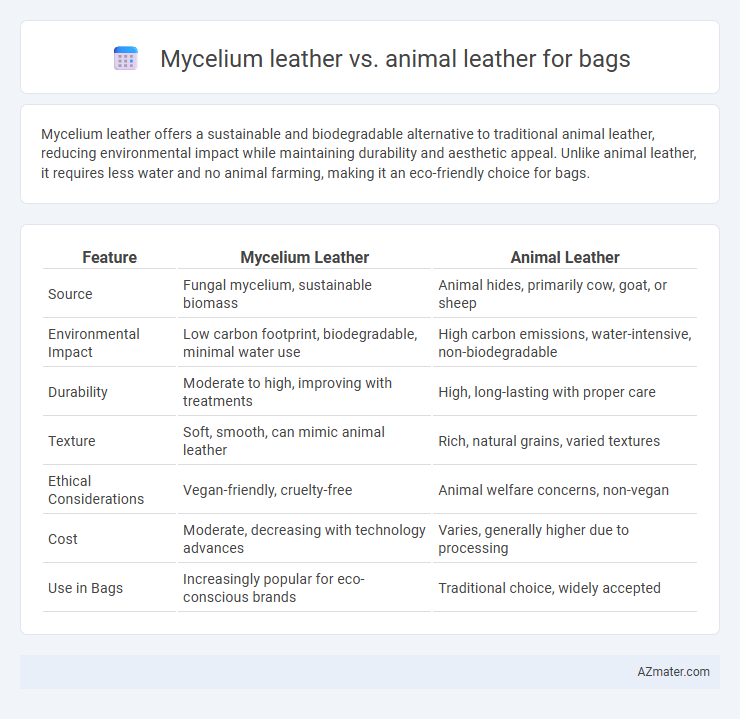Mycelium leather offers a sustainable and biodegradable alternative to traditional animal leather, reducing environmental impact while maintaining durability and aesthetic appeal. Unlike animal leather, it requires less water and no animal farming, making it an eco-friendly choice for bags.
Table of Comparison
| Feature | Mycelium Leather | Animal Leather |
|---|---|---|
| Source | Fungal mycelium, sustainable biomass | Animal hides, primarily cow, goat, or sheep |
| Environmental Impact | Low carbon footprint, biodegradable, minimal water use | High carbon emissions, water-intensive, non-biodegradable |
| Durability | Moderate to high, improving with treatments | High, long-lasting with proper care |
| Texture | Soft, smooth, can mimic animal leather | Rich, natural grains, varied textures |
| Ethical Considerations | Vegan-friendly, cruelty-free | Animal welfare concerns, non-vegan |
| Cost | Moderate, decreasing with technology advances | Varies, generally higher due to processing |
| Use in Bags | Increasingly popular for eco-conscious brands | Traditional choice, widely accepted |
Introduction to Mycelium Leather and Animal Leather
Mycelium leather, derived from the root structure of mushrooms, offers a sustainable and eco-friendly alternative to traditional animal leather, which is sourced from the hides of cows or other animals. This innovative material is biodegradable, requires less water, and produces fewer carbon emissions during production compared to conventional leather. Animal leather remains preferred for its durability and natural texture, but the growing demand for vegan and cruelty-free products is boosting the popularity of mycelium leather in the fashion industry.
Production Process: Mycelium vs Animal Leather
Mycelium leather is produced through a sustainable process involving the cultivation of fungus roots that grow into a dense, leather-like material within weeks, minimizing environmental impact and resource use. In contrast, animal leather production requires raising livestock, which involves extensive land, water, and feed consumption, followed by energy-intensive tanning processes that often use harmful chemicals. The mycelium leather process offers a biodegradable and eco-friendly alternative, significantly reducing carbon emissions and pollution compared to traditional animal leather manufacturing.
Environmental Impact: Sustainability Comparison
Mycelium leather, derived from fungal roots, offers a significantly lower environmental footprint compared to traditional animal leather, utilizing less water, land, and energy while producing minimal greenhouse gas emissions. Animal leather tanning generates substantial pollution through chemical use and deforestation linked to livestock farming, contributing heavily to carbon emissions and habitat loss. Opting for mycelium leather bags supports sustainable production practices by promoting biodegradable materials and reducing dependency on intensive animal agriculture.
Material Properties: Strength and Durability
Mycelium leather exhibits impressive strength and durability comparable to traditional animal leather, benefiting from its dense fibrous network that resists wear and tear effectively. While animal leather is known for its long-lasting resilience and natural toughness, mycelium leather offers enhanced flexibility and lightweight properties without compromising structural integrity. Both materials provide excellent durability for bags, but mycelium leather's sustainable and biodegradable composition presents an innovative alternative with competitive physical performance.
Aesthetic Differences: Texture and Appearance
Mycelium leather offers a unique texture that resembles natural grain but with a slightly more uniform and matte finish compared to the varied patterns and glossy surface of animal leather. The appearance of mycelium leather can be tailored during the cultivation process, resulting in a consistent and modern aesthetic ideal for contemporary bag designs. Animal leather features a rich patina that develops over time, adding depth and character to bags, while mycelium leather maintains its original look with minimal aging effects.
Ethical Considerations: Cruelty-Free vs Traditional Methods
Mycelium leather offers a cruelty-free alternative to traditional animal leather by eliminating the need for animal farming, reducing harm to animals and supporting sustainable ethical practices. Animal leather production involves livestock raising, which raises concerns about animal welfare, deforestation, and high greenhouse gas emissions. Choosing mycelium leather for bags aligns with ethical consumerism, minimizing environmental impact and promoting cruelty-free fashion.
Cost Analysis: Affordability and Market Value
Mycelium leather offers a cost-effective alternative to traditional animal leather, with production expenses significantly lower due to faster growth cycles and reduced resource consumption. While animal leather bags typically command higher market prices reflecting their heritage and durability, mycelium leather products are increasingly gaining market value as sustainable fashion trends rise. Affordability of mycelium leather bags appeals to eco-conscious consumers seeking budget-friendly options without compromising style or quality.
Performance in Bag Manufacturing
Mycelium leather offers superior sustainability and breathability compared to traditional animal leather, making it an eco-friendly alternative in bag manufacturing. It demonstrates high durability and lightweight properties, enhancing the functional performance of bags without compromising strength. Production of mycelium leather also involves lower carbon emissions and water use, optimizing the environmental footprint in the manufacturing process.
Consumer Acceptance and Market Trends
Mycelium leather is gaining significant consumer acceptance due to its sustainable and cruelty-free attributes, appealing to eco-conscious buyers seeking alternatives to traditional animal leather. Market trends indicate a rapid increase in demand for mycelium-based products, driven by rising awareness of environmental impact and innovations in texture and durability. Animal leather remains preferred for its established luxury status and durability but faces declining popularity among younger consumers favoring ethical and plant-based materials.
Future Prospects of Mycelium and Animal Leather
Mycelium leather presents a sustainable alternative to animal leather with rapid growth cycles and lower environmental impact, making it highly promising for eco-conscious fashion industries. Advances in biotechnology are improving mycelium's durability and texture, aligning its properties closer to traditional animal leather without ethical concerns. While animal leather maintains a luxury market niche due to its established quality and heritage, increasing regulations and demand for cruelty-free products are driving innovations towards mycelium leather's widespread adoption in future bag manufacturing.

Infographic: Mycelium leather vs Animal leather for Bag
 azmater.com
azmater.com